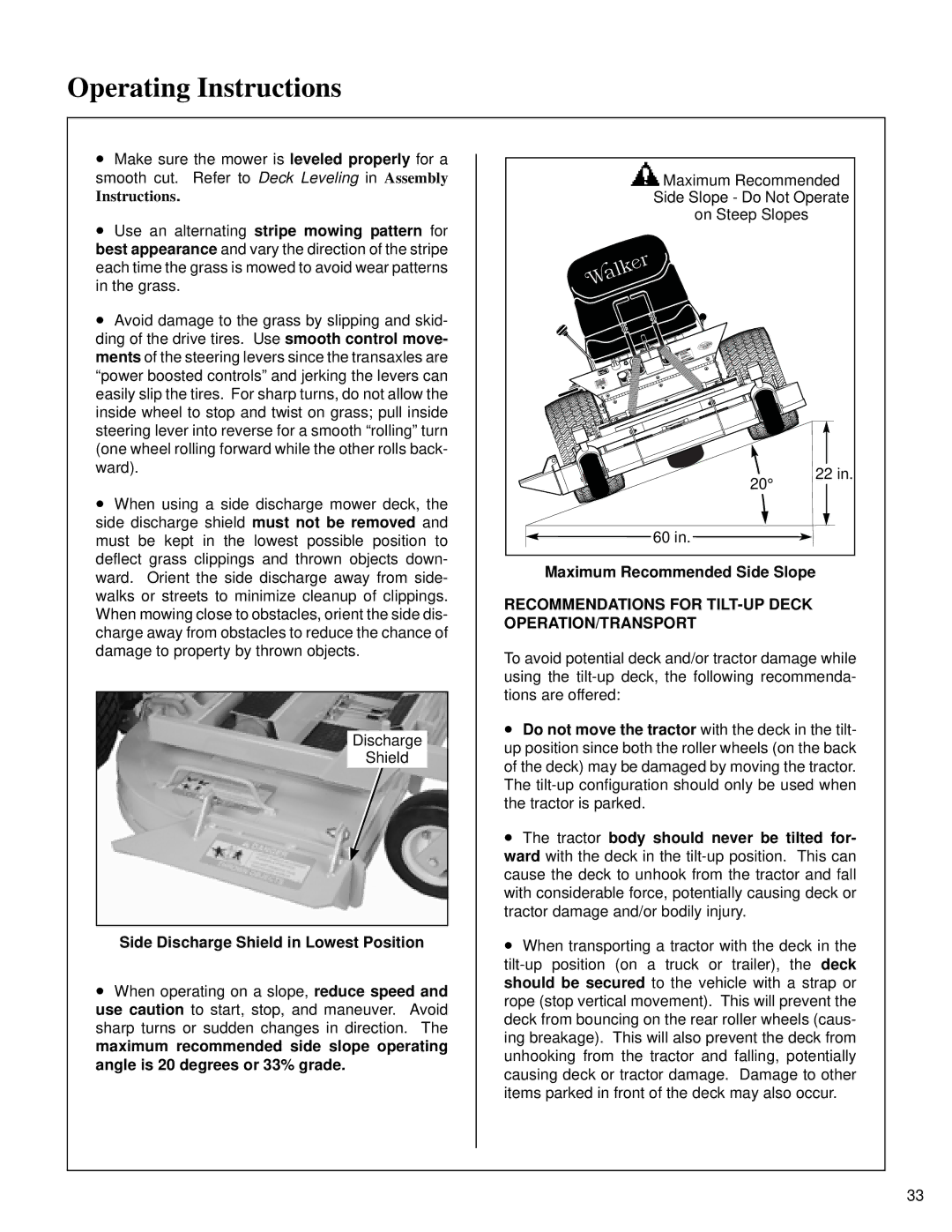Illustrated Parts Manual
Foreword
Table of Contents
Spread Tail Wheel Axle KIT
Main Component
Hydrostatic Ground
Steering Control Assemblies
Fill In By Purchaser
General Information
Glossary
Identifying Number Locations
Servicing of Engine and Drivetrain Components
Transmission
Specifications
Engine
Electrical System
Tire Pressure
Blade Drive
Tire Size
FRAME/BODY Construction
Mower Deck
Drive Belts
Seat
Front View and Right Side View
Component Identification
Rear View and Left Side View
Top View Body Raised
Do not mow with bystanders in the area
Safety Instructions
Before Operating
Operating
Case of a clogged or plugged mower deck
Maintenance
Safety Instructions
SAFETY, CONTROL, and Instruction Decals
SAFETY, CONTROL, and Instruction Decals
Deck Caster Wheel Installation
Assembly Instructions
Setup Instructions
Battery Service
PTO Shaft Connection
PTO Shaft Guard Installation
Deck Installation
Mower Deck Installation
Deck Counterweight Spring Installation
Deck Leveling
Body Rod in Stowed Position
Body Rod in Engaged Position
Check Engine Crankcase OIL Level
Adjust Mower Cutting HEIGHT, if RE- Quired
Operating Controls
Operating Instructions
Control IDENTIFICATION, LOCATION, and Function
Choke and Throttle Location Forward Speed Control FSC
PTO Switch
Engine Choke
Engine Throttle
Hydro Lockout Rod Location Hourmeter
Operating Controls Top View from Drivers Point of View
Left Wheel Right Wheel Steering Lever
Disengaged
Adjusting Ground Speed and Steering
Starting the Engine
Correct Operator Hand Position on the Controls
Blade Clutch Engaged Blade Clutch Disengaged
Engaging the Mower
Stopping the Machine
Cutting Height Adjustment
Recommendations for Mowing
Transaxle Lockouts
Hydro Lockout Rod Freewheel Position
Hydro Lockout Rod Normal Operating Position
Maximum Recommended Side Slope
Side Discharge Shield in Lowest Position
Service Item 100 250 Daily Hours Yearly
Maintenance Instructions
Important Tips for Care of the Briggs & Stratton Engine
Dipstick Operating Range
Lubrication
Engine Oil
Each USE
Grease Fitting and Oil Point Lubrication
Dipstick and Oil Fill View from above left side of tractor
Lubrication
Maintenance Instructions
Transaxle Lubrication
Mower Deck Gearbox Lubrication
Transaxle Drain Plugs View from underside of tractor
Cleaning
Keep Engine Screen Clean
Transaxle Oil Filter Location
Clean Cooling Fins and Fan Air Cleaner System
Cleaning
CHECKING/SERVICING
Deck Secured in Tilt-Up Position
Tire Pressure
Battery
Cleaning the Terminals
Batteries Produce Explosive Gases
Drive Belts
Mower Blade Profile For Sharpening
Blade Balanced on Magnetic Wall-Mounted Balancer
Belt Locations
REPLACING/REPAIRING
Spark Plugs
Breaker Points
Engine/PTO Belt Engaged
Engine/PTO Belt
Remove Belt Guard
Engine/PTO Belt Disengaged
Ground Drive Belt Assembly Engaged
Ground Drive Belt Assembly Disengaged
PTO Shear Pin
Fuel Filter
Fuel Filter Location
Cutting Blade Shear Bolts
Mower Blades
Steering Handles Adjustment Step
Adjustments
Steering Lever Position Adjustment Step
Stop Bolt Location Stop Bolt Adjustment
Actuator Rod Length Adjustment
Steering Lever Adjustment
Neutral Position Adjustment Step
FSC Position Steering Adjustment
Neutral Travel End
Full Forward Speed Adjustment Step
Straight Tracking Adjustment Step
Neutral Window
Forward Speed Control Friction Adjustment Step
Neutral Travel End Adjust
Neutral Switch Adjustment Step
FSC Switch Location
Tilt-Up Deck Adjustable Stop
ADJUSTMENTS/ Electrical System
0DLQWHQDQFHHFDOV
75$&725&$/6
Refer to Decks Parts Manual 13 for Deck Decals
KDVVLV$VVHPEO\
+$66,6$660%
7LOW8S/DWFK$VVHPEO\
Dvwhqhuv
F009
372ULYH$VVHPEO\ Dvwhqhuv
$,1&203211732575$160,66,21
F051
KRNHDQG7KURWWOH$VVHPEOLHV
5283
XHO7DQN$VVHPEO\
F392
3DUNLQJ%UDNH$VVHPEO\
+5267$7,&*52815,9$660%/,6
URXQGULYH$VVHPEOLHV
F066
7UDQVPLVVLRQ6SULQJ$VVHPEOLHV
675,1*&21752/$660%/,6
6WHHULQJ/HYHU6&$VVHPEOLHV Dvwhqhuv
F183
OHFWULFDO$VVHPEO\ Dvwhqhuv
75,&$/$660%
Detail a
6SUHDG$OH.LW Dvwhqhuv
635$7$,/+/$/.,7
F016
6&+0$7
Limited Warranty For Walker Model MB Rider Mower
Sound Test
Sound Model MB

![]() Maximum Recommended
Maximum Recommended